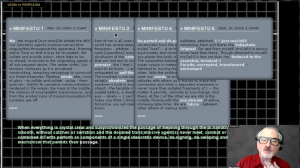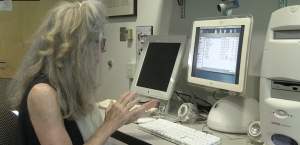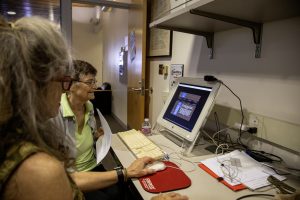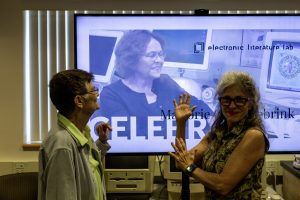Final Report: Making Shockwave Archives Accessible
by Dene Grigar, PhD, Director, The Electronic Literature Lab, Washington State University Vancouver
Tracking document: https://docs.google.com/spreadsheets/d/1FFS8soClkctSoFLeORqXnclTzps_KBUKfvibTaEmeto/edit?usp=sharing.
This is the final report for “Making Shockwave Archives Accessible,” a project undertaken by the Electronic Literature Lab at Washington State University Vancouver. The Society of American Archivists awarded the lab the Catalyst grant to: 1) create formal video recordings, what we call Traversals, of each of the 78 works of born-digital literature, art, and games produced with Shockwave Director and held in archive in the virtual museum/library called The NEXT (https://the-next.eliterature.org), and 2) make the Traversals accessible on the works’ exhibition spaces.
With the project now completed, we are reflecting on our efforts and presenting the activities this project has generated.

1.0: Our Work
1.1 Recorded Works
We had originally planned to document 78 works held in The NEXT created with Shockwave Director. Seven of the works we had planned to record were broken. These include:
- Jaime Levy’s “Cyber Rag III” (The Sarah Smith Collection), published in 1991 on 3.5-inch floppy disk using Macromedia Director. It ran into a memory error on all machines, including on the Power Macintosh G3 running native 9.2.2
- Eric Riel’s “Theatralis” (The Turbulence Collection), published in 1999 on the Web. It has external links embedded in the Shockwave file itself leaving only the first two screens of the work accessible
- Riel’s “Telesthetic Communis” (The Turbulence Collection), published in 2001 on the Web. It has external links to Turbulence.org embedded in the Shockwave file itself; because we are not hosting the Turbulence domain, we could fix this problem
- Marie-Laure Ryan’s “Symbol Rock” (The Marjorie C. Luesebrink Collection), published in 2003 on CD-ROM. The CD-ROM has a bad sector on it and, so, cannot be accessed
- Xavier Pehuet’s “Ekpurosis” (The Turbulence Collection), published in 2003 on the Web. Its .dcr file is try trying to pull data from two .cct files we do not have access to without the original Director files and, so, cannot load
- Eugene Tisselli’s “synonymovie” (Electronic Literature Collection Volume 2 Collection), created in 2004 and published on the Web. It makes use of an “online search engine” to pull its images. Even though the interface is working, the piece cannot generate anything because whatever search engine it used is gone.
- The Labyrinth Project’s “Cultivating Pasadena: From Roses to Redevelopment” (The Vectors Collection), published on the Web in 2005. It attempts to pull the audio and image files from the original URLs, which are no longer functional
This brought our number to 71.
As we studied the files for each of the works, we realized that some of the works we thought were Shockwave Director were actually Shockwave Flash works that we could easily preserve with Conifer or Ruffle. We removed these works from the list to record.
We went back through the over 3000 works held in The NEXT and identified others that could benefit from video recording. In some cases, like Stephanie Strickland’s “slippingglimpse” (2007), they are complex works produced with Shockwave Flash that did not respond well to its translation via Conifer or Ruffle. In other cases, like Talan Memmott’s “Lexia to Perplexia” (2000), they required extensions no longer found on contemporary browsers to function effectively. In the end, we added seven works. They include:
- Art Spiegelman’s “The Complete Maus” (1991); The Voyager Collection
- Robert Mohl’s “Planetary Taxi” (1993); The Voyager Collection
- Kikudo Iwano’s “Shining Flower” (1993); The Voyager Collection
- Rodney Alan Greenblat’s “The Dazzleoids” (1994); The Voyager Collection
- James Petrillo’s “Cinema Volta” (1994); The Voyager Collection
- Talan Memmot’s “Lexia to Perplexia” (1999); The Riding the Meridian Collection, The Electronic Literature Collection Volume 1 Collection, and The Iowa Review Web Collection
- Stephanie Strickland’s “slippingglimpse” (2007); The Electronic Literature Collection Volume 2 Collection, and The Stephanie Strickland Collection
The final number of works we documented is 75, dating from 1991 to 2008.
1.2: Hardware and Software Used

The Electronic Literature Lab holds 88 computers dating back to 1977 with operating systems that make it possible for us to access a variety of works. Several of our computers allow us access to works produced with Shockwave Director.
| Computers & Operating Systems | Number of Works Accessed |
| Power Macintosh G3 running Mac OS X 9.2.2 | 2 |
| iMac G3 (Tangerine) running Mac OS X 9.2.2 | 2 |
| iMac G4 (flat panel) running Mac OS x 10.3.9 | 13 |
| Power Mac G4 Tower running Mac OS X 10.4.6 | 56 |
| Custom-built PC Tower running Windows 11 Enterprise 24H2 | 2 |
Figure 1: Chart of computers and operating systems used in Traversals
As Figure 1 shows, all but two Traversals took place on Macintosh computers. Keeping this information in mind, it is also interesting to consider that the time frame most of the works were recorded coincides with what is considered the “heyday” of Shockwave Director: from the late 1990s to the early 2000s––before Adobe acquired the software in 2005 and Flash began to take over as the dominate software. As our Excel tracking document (see Appendix 1) shows, 54 of the 75 works we recorded were produced during that period. From this perspective, it makes sense the Power Mac G4 Tower, sold from 1999 to 2004, figures as the workhorse of our Traversals.
It is also important to note that the mainstreaming of the Web browser, beginning in the mid-1990s, brought about a shift away from the use of CD-ROMs for sharing digital files. As Figure 2 shows, only 30 of the 75 works recorded were accessed via CD-ROMs. The works published on the Web, but whose files were simply stored on this type of physical media, needed a variety of browsers to access for the purpose of recording the works.
| Browser Software | Number of Works Accessed |
| IE 4.5 (1998-2005) | 4 |
| IE 5.1.4 (2002-2005) | 44 |
| Safari 1.3.2 (2006-2007) | 2 |
| Pale Moon 33.8.0 (2025) | 1 |
Figure 2.: Chart of browser software used for Traversals
It is interesting to note that the dates reflecting the lifespan of browsers, shown in column 1 of the figure, coincides with the timeframe in which Director dominated the production of interactive media.
1.3 Traversals and the Recording Process
After learning we were awarded the grant on June 3, 2025, we began developing the Traversal schedule, organizing the work files, and preparing the computers. Traversals began two weeks later on June 17, 2025, and were completed on August 29, 2025.

This means we recorded close to 37 works a month, averaging nine a week, scheduled mostly to take place on Tuesdays and Thursdays, with an occasional shift to a Friday to accommodate artists’ schedules. Numerous artists and scholars specializing in criticism of particular artists were able to perform Traversals for us. One artist, Stephanie Strickland, was flown in with donated funds to perform two of her works and one by the late M. D. Coverley, in person. Four artists and scholars––Jim Andrews, Talan Memmott, Erika Fülöp, and Alexandra Martin–– joined us via Zoom while I navigated the work for them in the lab. One of the lab’s research affiliates, John Barber, performed 15 works. I did the rest of the Traversals.
With a few exceptions, all Traversals were able to take place on computers with video cards that made it possible to record screen actions, resulting in clear screen captures. All videos were edited to eliminate vocal errors and hesitation markers common in conversations. The length of videos was not prescribed but rather based on the length of work itself or the inclination of the performer to linger on a work. For example, the Traversal of M. D. Coverley’s interactive novel, Egypt: Book of Going Forth by Day (https://vimeo.com/1105279149), is 23 minutes in length while the one for Jim Andrews’ computer game, “Arteroids,” Version 2.02 (https://vimeo.com/1102005569), is closer to 15 minutes.
While we hold videos of playthroughs and Traversals on hard drives, we make them available at The NEXT via Vimeo. For each of the videos we uploaded for this project (as well as all others associated with The NEXT), we entered metadata on the Vimeo interface and set the access as “Attribution non-commercial share alike.”
The Traversals were, then, integrated into The NEXT. To do this, we added the URL generated by Vimeo for each work’s video into The NEXT’s dashboard of our test site and activated the Traversal button so that it appears on the work’s exhibition space, as seen in Figure 3. Our Metadata Specialist also updated each work’s information in the dashboard with information gleaned from Traversals, including dates, descriptions, and other pertinent metadata. The changes made on the test site were then pushed to the live site. This occurred on Thursday, September 4, 2025.
1.4 What We Have Learned
I have long said that we were racing against time with the preservation work we are doing in the lab. The hardware and software and the physical media do, indeed, have a lifespan, though none of us 30 years ago ever imagined that I would still be able to read Iwana’s Shining Flower (1993) using the CD-ROM on which The Voyager Company published it, much less on the Power Macintosh G3 on which it is accessible.
In so many cases we rely on the artists to provide missing files or in other cases, missing information. But artists, too, have a lifespan, and it is this one that affects us more deeply.
A case in point is our work to record Lehan Ramsay’s and Yskw’s “peephole,” published in 1999 in frAme, Issue 2. This work explores surveillance culture at a time when video cams were becoming common through services like CUSeeMe. The work’s files we received as part of the frAme archive are incomplete, making it impossible to provide an effective reflection of the work in a Traversal. All we did have were still images captured from what might have been the Flash output––we cannot know for certain. In cases like this one, we would reach out to the artist or the publisher to see if they can provide the missing files or information.
But Ramsay died in July 2016, the very year the lab began collecting archives. Searching the Web for documentation about the work or other places the work may have been published turned up nothing. Likewise, Sue Thomas, the founder of the trAce Online Writing Centre that oversaw the production of frAme, turned over the organization’s archives to her university when she took another position. Her university eventually took the server offline due to security risks. With Thomas’s support, in 2016 the university gave the lab the contents of the server on which all of the Centre’s archives were held, but a recent search during this project for “peephole’s” missing files among the thousands we moved to The NEXT’s archives brought up nothing we did not already have.
As mentioned, the files we do have give us an idea of what the work could have been like, and from them we can produce at least the images for the work’s exhibition space. But the loss of “peephole” as this artist had produced it represents the concern we have about a lot of artists, like Marjorie C. Luesebrink, who wrote under the name of M. D. Coverley, and Helen Thorington, the founder of Turbulence and an artist who also worked with Shockwave Director, who both died in 2023. Others, not part of this project’s scope but also who contributed greatly to the field who have also died, such as Randy Adams, Wilton Acevedo, and Jo-Anne Green, also make us keenly aware of the need to move quickly and more mindfully to preserve this work. Saving outmoded Storyspace and HyperCard works as well those produced with Director, Muse, and Flash works drives us, but losing artists gives our work purpose in that we wish to honor them through our efforts to keep their vision alive and available for future audiences to study.
2.0 Activities From This Project
2.1 Naming Celebration for ELL’s Reading Room

We received permission from my university to name ELL’s Reading Room for Marjorie C. Luesebrink, whom, I mentioned previously, wrote under the name M. D. Coverley. Luesebrink had long been a supporter of the lab and the work we have been doing with The NEXT, visiting us from her home in Southern California many times for events and gifting her physical and digital archives to us for The NEXT. The naming celebration, held on Wednesday, July 23, 2025, and documented on video, gave us the opportunity to integrate a Traversal into the event and publicize the project to members of the Electronic Literature Organization. Luesebrink’s close friend and collaborator, Stephanie Strickland, performed Coverley’s novel, Egypt: The Book of Going Forth by Day for the Traversal. Also, at the event we were joined online by other artists, such as Nick Montfort, and scholars of both Coverley’s and Strickland’s work, such as Lai-Tze Fan and Davin Heckman. The next day Strickland performed her own works on our list, V: Vniverse and “slippingglimpse.”
2.2 Retrospective of Talan Memmot’s Work
Memmot’s art figures largely in contemporary media criticism. N. Katherine Hayles, for example, has written extensively about “Lexia to Perplexia” in books like Writing Machines (The MIT Press, 2002) and Electronic Literature: New Horizons for the Literary (The University of Notre Dame Press, 2008). Even years after the work could no longer be experienced on contemporary browsers, Scott Rettberg discussed it in his book Electronic Literature (Polity Press, 2019). During Memmot’s Traversals for this project, I learned that he did not maintain his own archive and that what we are holding in The NEXT could very well constitute what is left of his early artistic practice. This realization led me to see that providing a retrospective drawn from the work we are holding in The NEXT, along with the more current work he does have available, would be a good contribution to the field. This exhibition would be hosted as one of our “Treasures” shows, joining the retrospective of M. D. Coverley’s “New Horizons” (https://the-next.eliterature.org/exhibition/horizon-insight/) exhibition that ran from 1 November 2021 to 31 March 2022. We aim for Memmott’s to open on 12 January 2026. We will be able to use the Traversals we produced for this exhibition.
2.3 Expanding Our Space
It was clear toward the end of our Traversals that the Power Mac G4 Tower was having difficulty. The strain of the many extensions it had to run to make Shockwave Director function was causing it to lock up and crash. Because it is one of the workhorses with a video card able to access this particular software, we needed to be prepared to replace it and/or to add additional computers to our arsenal of hardware as backup. But with 88 computers, we have been out of space for quite some time. The recent article about the lab in the BBC News and Stories (https://www.bbc.com/future/article/20250516-the-people-stuck-using-ancient-windows-computers) added to our hardware collection, particular PCs with a 5.25-inch floppy disk drive. What we now need are some computers that can be used for Traversals of works created with Director that can run the particular browser software it requires.
This situation led me to ask my university for a larger space to hold my equipment. My request was generously granted, and we will begin moving, in late September, our equipment from our Video and Sound Space where it has been stored, to four large rooms in the same building. Anyone reading this report knows how rare and special it is to get space. The new space will make it possible for us to dedicate a room to backup computers, organizing them on heavy duty shelving units; set up our library of software and manuals in a room containing bookshelves; develop a space for repairing computers; and organize our peripherals so that we can easily find items we need.
Final Thoughts
We appreciate the opportunity to undertake this project. Having the support of the SAA means a lot to us in that it shows that our work to archive born-digital art, literature, and games actually matter to people and organizations that matter. But as importantly, we care deeply about this form of human expression and are dedicated to keeping it accessible to the public. We thank you for the opportunity to do this meaningful work.
For access to Appendix A (our tracking document) go to: https://docs.google.com/spreadsheets/d/1FFS8soClkctSoFLeORqXnclTzps_KBUKfvibTaEmeto/edit?usp=sharing.
For access to a video explaining the need for this type of approach to preservation of born-digital art, literature, and games, see: https://vimeo.com/1115411147.

